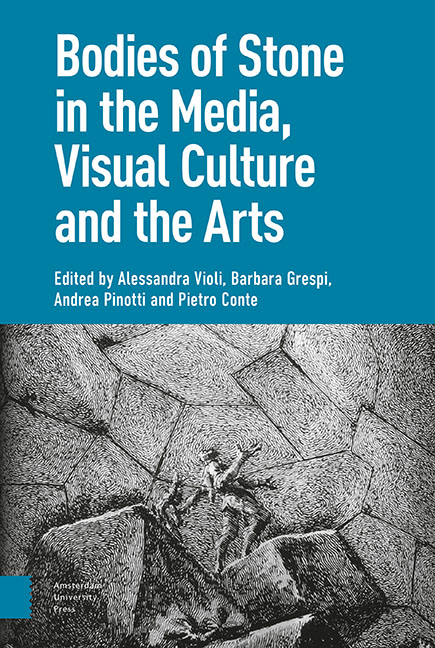Book contents
- Frontmatter
- Contents
- Introduction: Learning from Stone
- I Statue: The Imaginary of Uncertain Petrification
- 1 Theatre and Memory: The Body-as-Statue in Early Modern Culture
- 2 Translated Bodies: A ‘Cartographic’ Approach
- 3 Pantomime in Stone: Performance of the Pose and Animal Camouflage
- 4 Animated Statues and Petrified Bodies: A Journey Inside Fantasy Cinema
- 5 The Ephemeral Cathedral: Bodies of Stone and Configurations of Film
- II Matter: Size, Hardness, Duration
- 1 Bodies That Matter: Miniaturisation and the Origin(s) of ‘Art’
- 2 Brancusi’s ‘Sculpture for the Blind’
- 3 Cinema, Phenomenology and Hyperrealism
- 4 Ephemeral Bodies: The ‘Candles’ of Urs Fischer
- 5 The Celluloid and the Death Mask: Bazin’s and Eisenstein’s Image Anthropology
- III Corpse: Fossils, Auto-Icons, Revenants
- 1 Funeral Eulogy: Post-Mortem Figures and Redeemed Bodies, in Images
- 2 On Jack Torrance As a Fossil Form
- 3 Technical Images and the Transformation of Matter in Eighteenth-Century Tuscany
- 4 Glass, Mixed Media, Stone: The Bodily Stuffs of Suspended Animation
- 5 Bodies’ Strange Stories: Les Revenants and The Leftovers
- IV Monument: Embodying and Grafting
- 1 The Impassibly Fleshly, the Statue of the Impossible
- 2 Frozen into Allegory: Cleopatra’s Cultural Survival
- 3 The Orphan Image
- 4 The Well-Tempered Memorial: Abstraction, Anthropomorphism, Embodiment
- 5 Monuments of the Heart: Living Tombs and Organic Memories in Contemporary Culture
- Index
4 - Ephemeral Bodies: The ‘Candles’ of Urs Fischer
Published online by Cambridge University Press: 20 November 2020
- Frontmatter
- Contents
- Introduction: Learning from Stone
- I Statue: The Imaginary of Uncertain Petrification
- 1 Theatre and Memory: The Body-as-Statue in Early Modern Culture
- 2 Translated Bodies: A ‘Cartographic’ Approach
- 3 Pantomime in Stone: Performance of the Pose and Animal Camouflage
- 4 Animated Statues and Petrified Bodies: A Journey Inside Fantasy Cinema
- 5 The Ephemeral Cathedral: Bodies of Stone and Configurations of Film
- II Matter: Size, Hardness, Duration
- 1 Bodies That Matter: Miniaturisation and the Origin(s) of ‘Art’
- 2 Brancusi’s ‘Sculpture for the Blind’
- 3 Cinema, Phenomenology and Hyperrealism
- 4 Ephemeral Bodies: The ‘Candles’ of Urs Fischer
- 5 The Celluloid and the Death Mask: Bazin’s and Eisenstein’s Image Anthropology
- III Corpse: Fossils, Auto-Icons, Revenants
- 1 Funeral Eulogy: Post-Mortem Figures and Redeemed Bodies, in Images
- 2 On Jack Torrance As a Fossil Form
- 3 Technical Images and the Transformation of Matter in Eighteenth-Century Tuscany
- 4 Glass, Mixed Media, Stone: The Bodily Stuffs of Suspended Animation
- 5 Bodies’ Strange Stories: Les Revenants and The Leftovers
- IV Monument: Embodying and Grafting
- 1 The Impassibly Fleshly, the Statue of the Impossible
- 2 Frozen into Allegory: Cleopatra’s Cultural Survival
- 3 The Orphan Image
- 4 The Well-Tempered Memorial: Abstraction, Anthropomorphism, Embodiment
- 5 Monuments of the Heart: Living Tombs and Organic Memories in Contemporary Culture
- Index
Summary
Abstract
At the 54th Venice Biennale, Urs Fischer presented the most monumental of his ‘candles’: a 1:1 scale replica of Giambologna's The Rape of the Sabine Women. Together with two other wax sculptures—a copy of his favourite studio chair (a self-portrait) and the life-size statue of Rudolf Stingel (an alter ego)—it formed quite an eclectic sculptural group. But this ‘untitled’ installation was far from being an exercise in monumentality. At the Biennale opening, the sculptures were lit through candle wicks hidden in their bodies and started to melt. Though copies replaced the ‘originals’, Untitledresulted in a mass of ruins. More than a memento mori, it showed the passage of time focusing on the afterlife of images.
Keywords: Contemporary art; Urs Fischer; Venice Biennale; reenactment
At the 2011 Venice Biennale, in one of the spacious rooms of the Arsenale, Urs Fischer presented his most monumental ‘candle’: a 1:1 wax replica of Giambologna's Rape of the Sabine Women(c. 1580), a Mannerist masterpiece which, standing over four metres tall, is still to be found under the righthand arch of the Loggia dei Lanzi in Florence's Piazza della Signoria.
Fischer's choice was very fitting. Giambologna had shown proof of great technical virtuosity by carving his complex dynamic sculpture group from a single block of marble. And despite what legends say, not even the ancients had achieved so much. What's more, the sculpture was conceived in such a way as to be viewed from more than one standpoint, giving the impression of closing in on itself in an upwards spiral motion like a twisted column and encouraging the viewer to walk around it. Giambologna's skill in treating marble to make it look like malleable material is unprecedented: some bodily details of the three figures (a young woman raised by a man and an older man who crouches beneath them) are so life-like that they seem shaped in wax rather than carved from marble. Only Bernini would achieve comparable effects when representing Proserpina and her abductor, Pluto, in the Rape of Proserpina(1621).
Two other circumstances might have influenced Fischer's decision to take the Rape of the Sabine Womenas a theme and a model.
- Type
- Chapter
- Information
- Bodies of Stone in the Media, Visual Culture and the Arts , pp. 179 - 188Publisher: Amsterdam University PressPrint publication year: 2020



